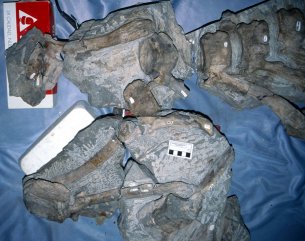LOCALIZACIÓN:
TIPO YACIMIENTO: Dinosaurios
EDAD: Maastrichtiense superior (Cretácico superior)
TIPO DE HALLAZGOS: Restos óseos
ORGANISMOS: Ornithopoda, Hadrosauridae, Sauropoda, Theropoda
ROCA QUE LOS CONTIENE: Areniscas
Descripción:
Los yacimientos de dinosaurios del municipio de Arén se encuentra en la comarca de Ribagorza en el Pirineo Huesca. En el paraje de Blasi se han localizado seis yacimientos, a los que denominamos Blasi 1 a Blasi 6 del más antiguo a más moderno, geológicamente hablando.Se encuentran situados en el flanco norte del sinclinal de Tremp, sinclinal de bloque superior de la lámina cabalgante del Montsec. Las rocas donde se encuentran se depositaron en un medio deltaico regresivo en la cuenca de foredeep sudpirenaica del Cretácico Superior. Hacia cuenca, abierta al océano Atlántico, las areniscas gradan a pelitas de prodelta y turbiditas, mientras que hacia continente pasan a sedimentos de transición y fluviales (Formación Areniscas de Arén y Formación Tremp respectivamente).
Los dinosaurios de Arén forman parte de una serie de descubrimientos de dinosaurios en Aragón producidos a lo largo del año 1997 que fueron noticia en los medios de comunicación locales, nacionales e internacionales. Fueron encontrados por los geólogos L. Ardèvol y F. López Olmedo durante unos trabajos de campo al oeste del núcleo urbano de Areny.
En 1997 comenzaron las excavaciones en las que se han recuperado cientos de restos articulados y desarticulados de dinosaurios y otros vertebrados. La importancia de estos yacimientos es doble, por una parte la gran cantidad y calidad de los restos que se han recuperado hasta el momento, y por otra que son los yacimientos más modernos del final del Cretácico que se han encontrado en Europa. Esto hace que los yacimientos de Arén sean una referencia a nivel mundial en el estudio de la extinción de los dinosaurios en esta parte de Europa.
Los restos fósiles de dinosaurios de los yacimientos de Blasi son abundantes y tienen buena conservación, habiéndose encontrado dos cráneos de hadrosaurio parcialmente articulados, uno en Blasi 1 y otro en Blasi 3. Su extracción y procesamiento en el laboratorio son lentos debido a que son yacimientos conservados en areniscas muy duras, por lo que parte del material se encuentra todavía en proceso de preparación. En un primer estudio se han reconocido 8 especies de dinosaurios, de los que los hadrosaurios son los más abundantes.
 Description:
Description:
Ichnites The sites with Cretaceous dinosaur ichnites at Arén are located on the north flank of the Tremp syncline, a synclinal of the upper block of the Montsec intraplate fold. The rocks that contain them were deposited in a regresssive delta environment in the Upper Cretaceous foredeep basin of the southern Pyrenees. Towards the basin, which opens towards the Atlantic Ocean, the sandstones grade to pro-delta pelites and turbidites, whereas towards the continent they become transition and fluvial sediments (Areniscas de Arén Formation and Tremp Formation respectively). The existence of dinosaur remains at Areny has been known since 1992, when the site of the dinosaur tracks was discovered and given the name “Arén”. With a view to preserving the site, changes were made to the route taken by the road between Lleida and France, which had initially passed through the site locality. At first, nine ichnites appeared on the fossiliferous level, spread over roughly 15m, while the rest was covered by talus and the western part of the upper stratum. For this reason, during the summer of 2000, an excavation was carried out that made it possible to distinguish two levels with ichnites (Areny I and II). Bone Remains The dinosaur sites in the municipality of Arén are located in the region of Ribagorza in the Pyrenees of Huesca. Six sites have been located at Blasi. These we have named Blasi 1 to Blasi 6, ranging from the oldest to the newest in geological terms. They are situated on the north flank of the Tremp syncline, a synclinal of the upper block of the Montsec intraplate fold. The rocks that contain them were deposited in a regresssive delta environment in the Upper Cretaceous foredeep basin of the southern Pyrenees. Towards the basin, which opens towards the Atlantic Ocean, the sandstones grade to pro-delta pelites and turbidites, whereas towards the continent they become transition and fluvial sediments (Areniscas de Arén Formation and Tremp Formation respectively). The Arén dinosaurs form part of a whole series of dinosaur discoveries made in Aragon in the course of 1997 that made the local, national and international news. They were found by the geologists L. Ardèvol and F. López Olmedo during field work they were doing to the west of the town of Areny itself.
Ichnites The sites with Cretaceous dinosaur ichnites at Arén are located on the north flank of the Tremp syncline, a synclinal of the upper block of the Montsec intraplate fold. The rocks that contain them were deposited in a regresssive delta environment in the Upper Cretaceous foredeep basin of the southern Pyrenees. Towards the basin, which opens towards the Atlantic Ocean, the sandstones grade to pro-delta pelites and turbidites, whereas towards the continent they become transition and fluvial sediments (Areniscas de Arén Formation and Tremp Formation respectively). The existence of dinosaur remains at Areny has been known since 1992, when the site of the dinosaur tracks was discovered and given the name “Arén”. With a view to preserving the site, changes were made to the route taken by the road between Lleida and France, which had initially passed through the site locality. At first, nine ichnites appeared on the fossiliferous level, spread over roughly 15m, while the rest was covered by talus and the western part of the upper stratum. For this reason, during the summer of 2000, an excavation was carried out that made it possible to distinguish two levels with ichnites (Areny I and II). Bone Remains The dinosaur sites in the municipality of Arén are located in the region of Ribagorza in the Pyrenees of Huesca. Six sites have been located at Blasi. These we have named Blasi 1 to Blasi 6, ranging from the oldest to the newest in geological terms. They are situated on the north flank of the Tremp syncline, a synclinal of the upper block of the Montsec intraplate fold. The rocks that contain them were deposited in a regresssive delta environment in the Upper Cretaceous foredeep basin of the southern Pyrenees. Towards the basin, which opens towards the Atlantic Ocean, the sandstones grade to pro-delta pelites and turbidites, whereas towards the continent they become transition and fluvial sediments (Areniscas de Arén Formation and Tremp Formation respectively). The Arén dinosaurs form part of a whole series of dinosaur discoveries made in Aragon in the course of 1997 that made the local, national and international news. They were found by the geologists L. Ardèvol and F. López Olmedo during field work they were doing to the west of the town of Areny itself. The excavations began in 1997. In the course of them, hundreds of articulated and disarticulated remains of dinosaurs and other vertebrates have been recovered. These sites have a dual importance: on the one hand the great quantity and high quality of the remains recovered so far, and on the other the fact that they are the most modern sites from the end of the Cretaceous to have been found in Europe. This makes the Arén sites a reference point on a worldwide scale in the study of the extinction of the dinosaurs in this part of Europe. The dinosaur fossil remains from the Blasi sites are abundant and well-conserved, including two partially articulated hadrosaur crania, one in Blasi 1 and the other in Blasi 3. Their extraction and laboratory treatment are slow because the sites are conserved in very hard sandstones. For this reason part of the material is still in the process of being prepared. In a preliminary study, eight species of dinosaurs have been recognised, of which the hadrosaurs are the most abundant.







 Description:
Description:














